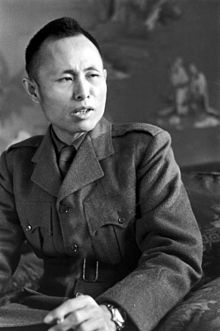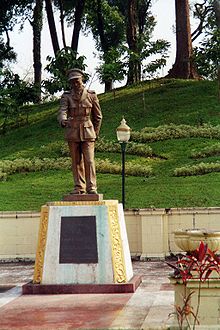Aung San
Bogyoke Aung San (Burmese ဗိုလ်ချုပ် အောင်ဆန်; b. 13 February 1915 in Natmauk (now Magwe Division, Myanmar), British India; † 19. July 1947 in Rangoon) was a commander of the Burma Independence Army (BIA) and president of the Anti-Fascist People's Freedom League (AFPFL). He is now a Burmese national hero. His title is Bogyoke, which means supreme military leader.
Aung San became known as a radical student leader during the 1930s. In 1939, he founded the Communist Party of Burma. A year later, he left for the Republic of China to study the Communist Party there. He arrived in Japanese-occupied Amoy, from where he was sent to Tokyo and received the hospitality of the military government. In 1941, Aung San secretly returned to Burma to recruit like-minded people for military training in Japan.
Thirty young men, who became known as the Thirty Comrades, went to Japan under Aung San's leadership and received military training; among them were U Nu, later prime minister, and Ne Win, later ruler. With 28 of them, Aung San returned via Thailand in December 1941. He raised an army to fight for Burmese independence, initially fighting alongside the Japanese - who had promised Burma independence in August 1943. When the Japanese promises proved false, Aung San switched sides with his army and declared war on the Japanese in March 1945. This aroused the interest of the Allied Supreme Commander in Southeast Asia, Lord Louis Mountbatten.
After the end of the Second World War in Asia, Aung San led the Anti-Fascist People's Freedom League (AFPFL). In the political struggle for independence, he was supported by both a paramilitary force and Mountbatten, who persuaded the British government to make concessions to the young politician. Aung San negotiated several crucial treaties that led to Burma's independence from Britain on January 4, 1948. He did not live to see this, however: on July 19, 1947, he and six other members of the Executive Council, including his older brother U Ba Win, were shot dead during a cabinet meeting in Rangoon. The five gunmen, as well as the ringleader U Saw, prime minister of the former colonial government, were hanged in January 1948. U Nu succeeded Aung San as party leader of the AFPFL.
Aung San married Daw Khin Kyi in 1942. Her daughter Aung San Suu Kyi, after her brothers Aung San Oo (living in the USA) and Aung San Lin (died at the age of eight) the youngest child from this marriage, is the best known fighter for democracy in Myanmar. For her commitment she received the Nobel Peace Prize in 1991. In 2016, after more than 50 years of rule by various military leaders, she finally succeeded in leading a democratic government together with the new president Htin Kyaw as state advisor and foreign minister.

Aung San (1940s)

Statue of Aung San on the north shore of Kandawgyi Lake in Rangoon
Search within the encyclopedia